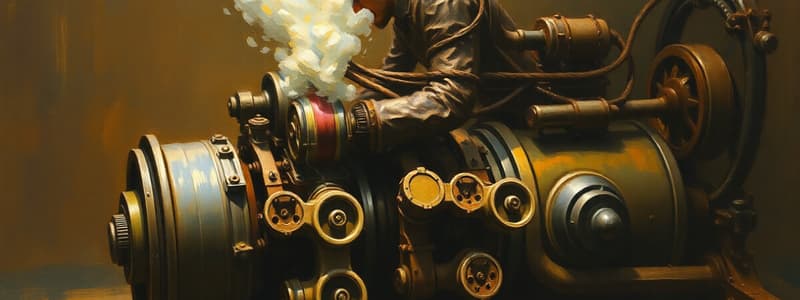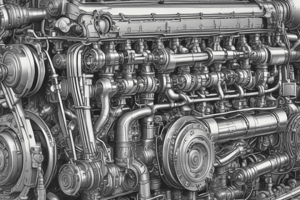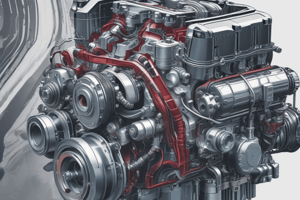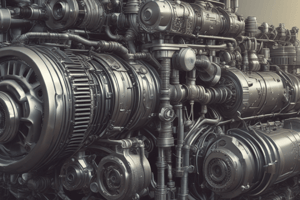Podcast
Questions and Answers
During which phase of the cycle is the exhaust valve opened?
During which phase of the cycle is the exhaust valve opened?
- 2nd Stroke
- 4th Stroke (correct)
- 3rd Stroke
- 1st Stroke
What is the pressure range during the compression in the 2nd Stroke?
What is the pressure range during the compression in the 2nd Stroke?
- 0.1 to 0.2 bar
- 10 to 16 bar (correct)
- 2 bar
- 40 to 60 bar
What must occur just before TDC in the 3rd Stroke to ensure proper combustion?
What must occur just before TDC in the 3rd Stroke to ensure proper combustion?
- The exhaust valve closes
- Ignition must be advanced (correct)
- The inlet valve opens
- The piston reaches BDC
How long is the interval between the spark and the flame being produced?
How long is the interval between the spark and the flame being produced?
What temperature can the exhaust gases reach at the end of the 4th Stroke?
What temperature can the exhaust gases reach at the end of the 4th Stroke?
What happens to the fuel-air mixture during the initial phase of the cycle?
What happens to the fuel-air mixture during the initial phase of the cycle?
What is the approximate vacuum pressure created during the intake phase?
What is the approximate vacuum pressure created during the intake phase?
How far does the crankshaft rotate for a complete cycle?
How far does the crankshaft rotate for a complete cycle?
What is the purpose of measuring the pressure pattern in an engine cylinder?
What is the purpose of measuring the pressure pattern in an engine cylinder?
What is the primary purpose of the camshaft in an engine?
What is the primary purpose of the camshaft in an engine?
How do the valve timings in an actual engine differ from the ideal conditions described?
How do the valve timings in an actual engine differ from the ideal conditions described?
What drives the intake and exhaust valves in an engine?
What drives the intake and exhaust valves in an engine?
Which component is responsible for pushing the valve off its seat?
Which component is responsible for pushing the valve off its seat?
What happens if there is a marked deviation from the normal pressure pattern during engine operation?
What happens if there is a marked deviation from the normal pressure pattern during engine operation?
How many cams are there for each cylinder in this engine system?
How many cams are there for each cylinder in this engine system?
Why are the lobes positioned differently on the camshaft?
Why are the lobes positioned differently on the camshaft?
During the four-stroke cycle, what indicates a cylinder is preparing for a new charge intake?
During the four-stroke cycle, what indicates a cylinder is preparing for a new charge intake?
When does the valve spring close the valve?
When does the valve spring close the valve?
Why is the exhaust expelled at very high speed from the cylinder?
Why is the exhaust expelled at very high speed from the cylinder?
What is the primary function of the piezo-electric indicator in engine testing?
What is the primary function of the piezo-electric indicator in engine testing?
What geometric concept is essential to understanding valve timing relative to the crankshaft?
What geometric concept is essential to understanding valve timing relative to the crankshaft?
What happens to the valve spring when the cam lobe raises the cam follower?
What happens to the valve spring when the cam lobe raises the cam follower?
What component contributes to closing the valves in an engine?
What component contributes to closing the valves in an engine?
What is represented by the full revolution of the crankshaft in terms of degrees?
What is represented by the full revolution of the crankshaft in terms of degrees?
How many degrees are covered by two full revolutions of a camshaft?
How many degrees are covered by two full revolutions of a camshaft?
What is the effective relationship between the turning speeds of the camshaft and crankshaft?
What is the effective relationship between the turning speeds of the camshaft and crankshaft?
At what crankshaft rotation does the intake valve begin to open relative to TDC?
At what crankshaft rotation does the intake valve begin to open relative to TDC?
What characterizes the rock position of a piston in an engine?
What characterizes the rock position of a piston in an engine?
How many strokes of the piston correspond to every complete revolution of the crankshaft?
How many strokes of the piston correspond to every complete revolution of the crankshaft?
How much crankshaft rotation occurs after BDC when the intake valve closes?
How much crankshaft rotation occurs after BDC when the intake valve closes?
What is the relationship between camshaft gear teeth and crankshaft gear teeth?
What is the relationship between camshaft gear teeth and crankshaft gear teeth?
What aspect of valve timing is emphasized for each valve opening during the piston cycle?
What aspect of valve timing is emphasized for each valve opening during the piston cycle?
Why does the intake valve open slightly before TDC?
Why does the intake valve open slightly before TDC?
What role does closing the exhaust valve after TDC play during the intake stroke?
What role does closing the exhaust valve after TDC play during the intake stroke?
What occurs when both the transfer port and exhaust port are covered?
What occurs when both the transfer port and exhaust port are covered?
What happens during the downward stroke of the piston in terms of the fuel charge?
What happens during the downward stroke of the piston in terms of the fuel charge?
How does the piston moving slowly affect the mixture entering the cylinder?
How does the piston moving slowly affect the mixture entering the cylinder?
What overall effect does the timing of the intake and exhaust valve operations have on the engine?
What overall effect does the timing of the intake and exhaust valve operations have on the engine?
What is the consequence of keeping the intake valve open until 45° past BDC?
What is the consequence of keeping the intake valve open until 45° past BDC?
What effect does atmospheric pressure have on the incoming mixture during the intake stroke?
What effect does atmospheric pressure have on the incoming mixture during the intake stroke?
What is a significant disadvantage of the radial engine?
What is a significant disadvantage of the radial engine?
What is one of the key strengths of the radial engine?
What is one of the key strengths of the radial engine?
How is an in-line engine typically constructed?
How is an in-line engine typically constructed?
What advantage does an 'inverted' in-line engine provide?
What advantage does an 'inverted' in-line engine provide?
Why might larger air-cooled in-line engines face issues?
Why might larger air-cooled in-line engines face issues?
What feature contributes to the better streamlining of an in-line engine?
What feature contributes to the better streamlining of an in-line engine?
What was the primary application of radial engines historically?
What was the primary application of radial engines historically?
Which of the following is NOT a characteristic of in-line engines?
Which of the following is NOT a characteristic of in-line engines?
Flashcards
Intake Stroke
Intake Stroke
The first step in a four-stroke engine cycle where the piston moves downwards, drawing in a mixture of air and fuel through the open intake valve.
Compression Stroke
Compression Stroke
The second step where the piston moves upwards, compressing the fuel-air mixture, increasing pressure and temperature.
Power Stroke
Power Stroke
The third step where the compressed fuel-air mixture ignites, creating a powerful explosion that pushes the piston down.
Exhaust Stroke
Exhaust Stroke
Signup and view all the flashcards
Valve Timing
Valve Timing
Signup and view all the flashcards
Camshaft
Camshaft
Signup and view all the flashcards
Ignition Advance
Ignition Advance
Signup and view all the flashcards
Combustion Pressure
Combustion Pressure
Signup and view all the flashcards
Cam Lobe
Cam Lobe
Signup and view all the flashcards
Cam Follower
Cam Follower
Signup and view all the flashcards
Push Rod
Push Rod
Signup and view all the flashcards
Rocker Arm
Rocker Arm
Signup and view all the flashcards
Valve Spring
Valve Spring
Signup and view all the flashcards
Geometric Circle
Geometric Circle
Signup and view all the flashcards
Crankshaft Degrees
Crankshaft Degrees
Signup and view all the flashcards
Four-stroke cycle
Four-stroke cycle
Signup and view all the flashcards
Piezo-electric indicator
Piezo-electric indicator
Signup and view all the flashcards
Indicator diagram
Indicator diagram
Signup and view all the flashcards
Valve operation
Valve operation
Signup and view all the flashcards
Valve open duration
Valve open duration
Signup and view all the flashcards
Abnormal indicator diagram
Abnormal indicator diagram
Signup and view all the flashcards
Engine setting impact
Engine setting impact
Signup and view all the flashcards
Top Dead Center (TDC)
Top Dead Center (TDC)
Signup and view all the flashcards
Bottom Dead Center (BDC)
Bottom Dead Center (BDC)
Signup and view all the flashcards
Rock Position
Rock Position
Signup and view all the flashcards
Revolution
Revolution
Signup and view all the flashcards
Radial engine
Radial engine
Signup and view all the flashcards
In-line engine
In-line engine
Signup and view all the flashcards
Inverted engine
Inverted engine
Signup and view all the flashcards
Weight-to-horsepower ratio
Weight-to-horsepower ratio
Signup and view all the flashcards
Frontal area
Frontal area
Signup and view all the flashcards
Air-cooled
Air-cooled
Signup and view all the flashcards
Liquid-cooled
Liquid-cooled
Signup and view all the flashcards
V-type engine
V-type engine
Signup and view all the flashcards
Late Exhaust Valve Closing
Late Exhaust Valve Closing
Signup and view all the flashcards
Early Intake Valve Opening
Early Intake Valve Opening
Signup and view all the flashcards
How Fuel-Air Mixture Enters Crankcase
How Fuel-Air Mixture Enters Crankcase
Signup and view all the flashcards
Fuel-Air Mixture Transfer
Fuel-Air Mixture Transfer
Signup and view all the flashcards
Port Coverage during Piston Upward Movement
Port Coverage during Piston Upward Movement
Signup and view all the flashcards
Benefits of Early Exhaust Valve Opening and Late Closing
Benefits of Early Exhaust Valve Opening and Late Closing
Signup and view all the flashcards
Intake Stroke Pressure Difference
Intake Stroke Pressure Difference
Signup and view all the flashcards
Late Intake Valve Closing
Late Intake Valve Closing
Signup and view all the flashcards
Study Notes
Piston Engine Fundamentals
- Piston engines are machines that convert heat energy from burning fuel into mechanical energy.
- These engines are categorized by power source (gas, oil, or steam), combustion location (internal or external), and movement of working parts (reciprocating, rotary, or turbine).
- Internal combustion engines burn fuel inside the cylinders.
- External combustion engines burn fuel outside the cylinders, such as steam engines.
- Reciprocating internal combustion engines (commonly used in aviation) use pistons that move back and forth inside the cylinders.
Four-Stroke and Two-Stroke Cycle Engines
- Four-stroke cycle engines complete a cycle of events (intake, compression, ignition, and exhaust) in four piston strokes.
- Two-stroke cycle engines complete the same cycle in two piston strokes.
- Four-stroke cycle engines generally offer better fuel efficiency.
- Two-stroke cycle engines offer greater power output per engine size.
- Four-stroke cycle operations include intake, compression, combustion, and exhaust.
Fundamental Engine Working Parts
- Cylinder: The main combustion and gas expansion chamber.
- Cylinder Head: Closes one end of the cylinder.
- Piston: Moves up and down inside the cylinder, with rings for a gastight seal.
- Connecting Rod: Connects the piston to the crankshaft.
- Crankshaft: Converts the reciprocating motion of the piston into rotary motion.
- Valve(s): Control the flow of air-fuel mixture into and out of the cylinder.
- Camshaft: Controls the opening and closing of the valves.
- Push Rods and Rocker Arms: Transmit camshaft motion to the valves.
Rotary Internal Combustion Engines (Wankel Engine)
- Rotary engine uses a rotary piston instead of reciprocating ones.
- The piston shape is trochoid.
- The energy from combustion is directly transferred to the shaft.
- The structure is more stable than traditional piston engines, with fewer vibrations.
Fundamentals of Engine Parameters
- Volumetric Efficiency (VE): Measures the amount of fuel/air mixture in the cylinder compared to the maximum possible volume.
- Thermal Efficiency: Measures the proportion of fuel energy converted to useful power.
- Mechanical Efficiency (ME): Measures the proportion of useful power output to the power produced internally by the engine.
- Piston Displacement (PD): The total volume of air/fuel mixture swept by the pistons.
- Compression Ratio: The ratio of the maximum and minimum cylinder volumes.
Operating Principle
- The operating principle of reciprocating engines involves taking in fuel/air, compressing, burning the mixture to create expansion of gases, then removing the exhaust gases.
- These actions take place in a cycle within either two or four strokes of the piston and each piston stroke translates into movement of the entire crankshaft from one end of its trajectory to the other.
Valve Operation
- Valves control the flow of mixture or gases into and out of the cylinder.
- Valve timing helps improve engine efficiency and fuel economy.
- Camshaft actions control valve opening and closing times.
- The timing is important to have optimum fuel/air mixture for proper combustion.
Principles of Diesel Engine Operation
- Diesel engines ignite fuel by heat from compression rather than a spark.
- Compression raises the temperature of the intake air.
- Fuel is injected into the highly compressed air, and combustion occurs.
Speed and Power Control
- Diesel engines use timing of compression and fuel injection to control speed and power.
- Air is pre-compressed in diesel engines, followed by the fuel injection.
Classification of Reciprocating Engines
- Engines are classified by cylinder arrangement (in-line, V-type, opposed, and radial).
- Their design affects engine performance, weight, cooling, and other characteristics.
Radial Engines
- Radial engines have cylinders arranged in a circle around a central crankshaft.
- They were once popular in aircraft.
- Rotary and static-radial types exist.
Designation of Reciprocating Engines
- Manufacturer codes are used to identify engine models.
Firing Order and Ignition Interval
- Firing order is the sequence by which cylinders ignite.
- Timing is precise to ensure smooth functioning.
Studying That Suits You
Use AI to generate personalized quizzes and flashcards to suit your learning preferences.





